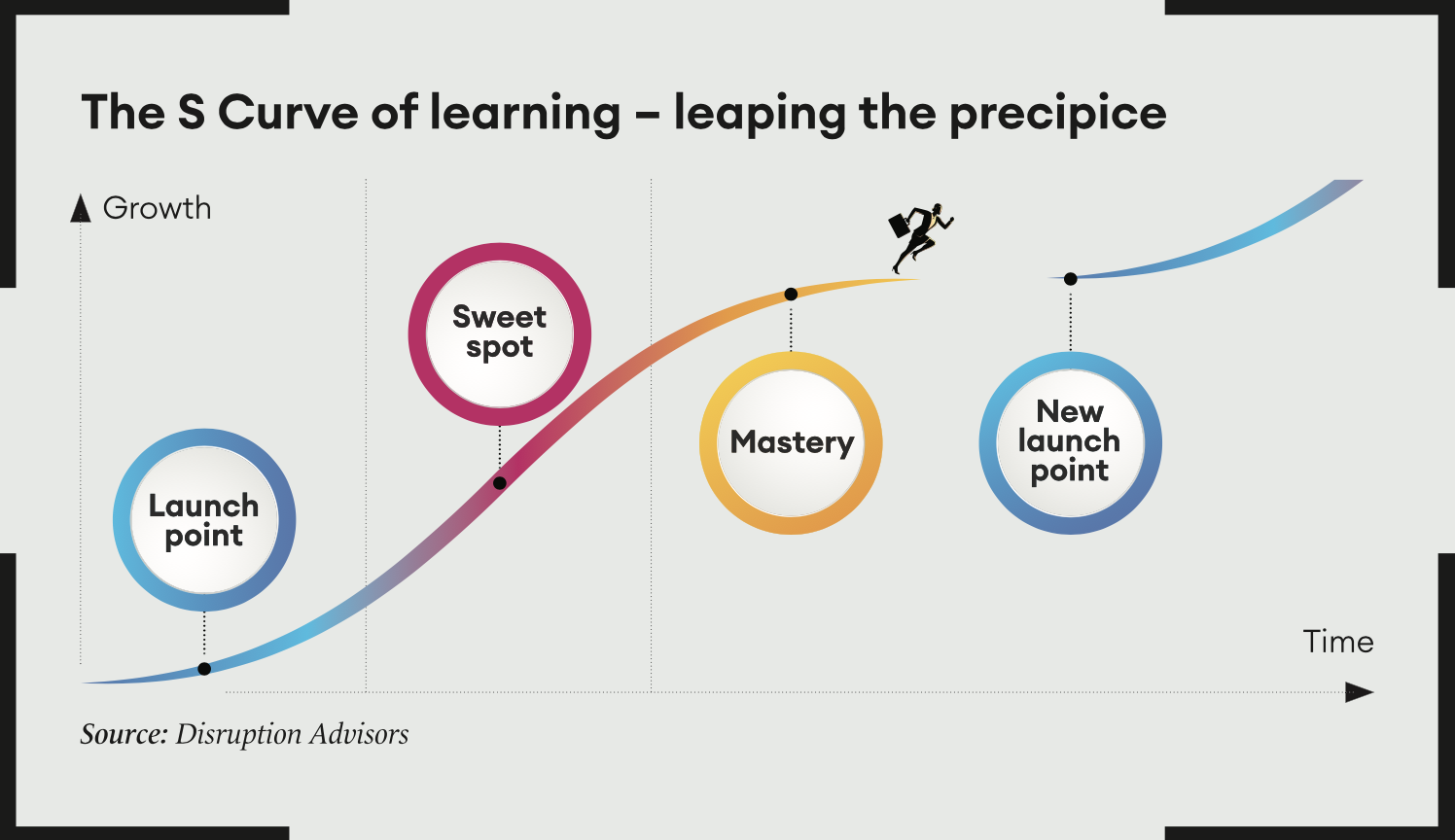When you’re at the top of your game, the risk of sharply declining performance is – counter-intuitively – at its greatest. Are you ready to make the leap into a new phase of growth?
Are you trapped on the alluring but perilous plateau of Mastery? On the S Curve™, our model of human growth, the high, flat end of the S represents Mastery. Here, we have reached our objective, and ease displaces effort. Mastery is great in theory: employers love their people to be fully qualified, even over-qualified, for their roles. They often hire and promote that way. Employees also like Mastery – for a while. It’s comfortable and there are few real challenges. The problem is we don’t work optimally in Mastery for very long.
Mastery is a plateau that becomes a precipice. We’ve exhausted the growth experience available on our S Curve, and we stagnate. We start phoning it in. Mastery is where an employee who is very, very good at what they do begins to feel like they can’t do it anymore. Their job is simply too boring. There’s no feeling of being stretched and little sense of accomplishment. They need a new S Curve to climb.

The S Curve and the perils of Mastery
Each new skill learned or challenge faced is its own S Curve. We start at the relatively flat Launch Point each time we begin something new, then move to the steep-sided Sweet Spot as we gain momentum and knowledge, and end in the flat plateau of Mastery when we’ve reached our objective.
Mastery is appealing. It offers a sense of security, a safe haven where one’s competence is unquestioned because we are masters at our craft. But herein lies the paradox: as leaders bask in the glow of their Mastery, they risk becoming prisoners of their own success. The sheer reality of being at the top can stifle their future growth and potential.
It’s akin to mountaineering, where the summit is the goal – the high end of the climbing S Curve. But it’s rarely safe to stay at a summit for long. The world’s highest and most demanding mounts boast altitudes of 26,000 ft or more above sea level. Their peaks are death zones: stopping for long can be fatal, as oxygen levels at such altitudes are insufficient to sustain human life for an extended period of time. Mountaineers who reach the peak of the tallest mountains are at a high risk of anoxia, an absence of oxygen reaching the body’s tissues. Similarly, Mastery can be its own death zone for growth, particularly when we perceive our current peak to be the highest one possible for us. There isn’t enough growth at this point to sustain us for long.
Learning – or rather, the brain activity and chemicals associated with learning – is the oxygen of human growth. Our brains are complex and malleable supercomputers that, due to neuroplasticity, physically change when we learn. Each time we run a hypothesis as a part of our brains’ highly attuned prediction models, new synapses form between neurons that were not previously connected. Our brains run these predictive models constantly, making an incredible number of predictions each day, building or strengthening neural connections, and ultimately impacting our conscious and subconscious actions.
But these predictions don’t just impact our actions. They also impact our feelings and drive, because of the influence of dopamine, the feel-good chemical responsible for making us feel motivated. When we predict something correctly, we are rewarded with a small dopamine spike. It feels good, and we want to get it right again. We learn to take the actions that deliver dopamine, strengthening those neural pathways. Our brain creates new synapses, new pathways, and we learn. We grow.
At the high end of the S Curve, in Mastery, our actions become automatic. Our competence is high, but our brain rewards are low. We don’t get the dopamine spike that we once had, because we are no longer uncertain. We know our predictive model is accurate, so we are no longer rewarded when we guess correctly. We are no longer creating new synapses, but rather are taking the well-developed pathways we’ve created. We’re becoming anoxic; our interest and engagement are dying due to lack of learning and growth. Disengagement results, and productivity declines. We struggle to force ourselves to do things we once did easily and well, or we do them without focus or care.
The performance precipice
The impact of plateaued growth on executive performance is illustrated by a study titled ‘The CEO Life Cycle’ published in the Harvard Business Review, November-December 2019. Researchers at Spencer Stuart tracked the year-by-year financial performance of more than 700 S&P chief executives and demonstrated five distinct phases of job performance, starting with the “honeymoon” and concluding with the “golden years”.
Those chief executives who last to year 11, when the golden years typically begin, must first survive the death zone of success. The peak of a chief executive’s S Curve is around year six. It is “often followed by a time of prolonged stagnation and mediocre results”. Many CEOs quit or are fired in this stage; they only reach the golden years if they deliberately and repeatedly reinvent themselves on new S Curves. “CEOs who survive the complacency trap typically go on to experience some of their best value-creating years,” write the study’s authors.
This is why top-performing employees are often the biggest flight risk. It’s why the quality of their work may decline after years of high performance. They don’t just want a new job; they need one. Employees who cannot see new learning opportunities for themselves within an organization will look externally for them – and when they find one, they will leave.
Employees and their managers should regularly meet to talk about the employees’ perceptions of their own growth and their future potential. Good leaders should proactively hold these discussions and be prepared with new in-house opportunities for the employees they most want to retain. Valuable human resources need to know that their growth is a high organizational priority.
Fortunately, once-valuable employees who are in decline can be valuable again. If you feel that you are on a plateau that’s becoming a precipice, you may want to talk to your manager about a new S Curve to climb within your organization before you decide to jump to a new one.
If you manage others, to retain and revitalize valuable human resources, you should be prepared to provide employees with in-house opportunities that align with their aspirations and the organization’s needs. These opportunities can range from new projects and responsibilities, to mentorship programs. The key is to offer employees a new S Curve to climb within the organization, rekindling their passion and motivation.
At the end of every S Curve there is a growth cliff precipice that leads straight down into the unknown. The question you must ask yourself is: Am I going to walk off this cliff edge, disoriented from a lack of oxygen, or am I intentionally going to sprint to the precipice and jump toward the bottom of the next mountain?
Making the leap
 Now that you know the science of growth and the dangers of staying at the peak too long, how can you intentionally jump off the Mastery precipice?
Now that you know the science of growth and the dangers of staying at the peak too long, how can you intentionally jump off the Mastery precipice?
1 Understand the importance of change, and the risk of not changing. Recognize that Mastery in your current role can turn into a plateau over time. Be open to change and new challenges as they arise in your career journey.
2 Proactively assess your current growth capacity. Regularly assess your own growth and potential. Don’t wait for your manager to initiate discussions about your development. Take charge by actively evaluating your progress.
3 Deliberately and clearly communicate. Initiate conversations with your manager about your perceptions of your growth and potential. Effective leaders proactively engage in discussions about employee development. Be an active participant in these conversations.
4 Stay alert for signs of complacency. Be vigilant for signs of complacency, such as boredom and a lack of motivation. Recognize that these feelings can indicate that you’ve reached the Mastery plateau and need to venture into new territory.
5 Amp up your curiosity. The person who wins is the person who is curious. Wonder about what you don’t know.
6 Seek new learning opportunities. Actively seek out opportunities within your organization to take on new projects or responsibilities that challenge you and contribute to your personal and professional growth.
7 Harness the power of neuroplasticity. Understand that the brain thrives on growth and learning. Challenge yourself to stimulate neuroplasticity and reward your brain with the release of dopamine as you achieve new milestones.
8 Explore new opportunities within your current organization. Before hastily considering a move to a new job, discuss the possibility of embarking on a new S Curve within your current organization with your manager. Internal opportunities may be more abundant than you think.
9 Appreciate the art of reinvention. Understand that reinventing yourself on new S Curves can lead to some of your most valuable and fulfilling years in your career. Appreciate that change is an opportunity for growth.
10 Take ownership of your growth and development. Remember that the responsibility for your own growth ultimately lies with you. Seek out opportunities, set goals, and actively engage in your own career progression. Don’t rely solely on others to drive your development.
New beginnings
Every S Curve, every new learning and growth journey, has a beginning, middle and end. We will all reach Mastery in our roles at some point or another. It is a desirable destination – but it should not be the journey’s end. The plateau of Mastery, when not recognized and addressed, can lead to stagnation and declining engagement.
By contrast, those who can successfully navigate Mastery and intentionally leap to a new S Curve will ensure that their career remains dynamic, engaging, and filled with opportunities for personal and professional growth. If you understand the science of growth, embrace reinvention, and foster opportunities for your team members to embark on their own new S Curves, you can help them escape the death zone too – ensuring sustained success for yourself and your organization.
Whitney Johnson is the author of Smart Growth: How to grow your people to grow your company, and CEO and co-founder of Disruption Advisors. Amy Humble is president and co-founder of Disruption Advisors.



